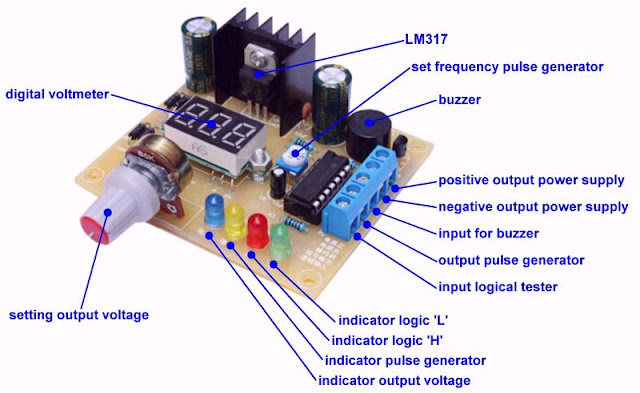Introduction to this cheap power supply kit
What do you get for your money?
You should not expect too much from this power supply. Of course this is not possible at this price and with a transformer of only 3.5 cm x 3.0 cm x 1.5 cm. The only specification the manufacturer gives is that the output power is 2 W and the output voltage is adjustable between 1.25 V and 12.0 V. According to Ohm's law, 2 W at 12 V represents a maximum current of 160 mA. Considering the dimensions of the supplied heatsink and the transformer, that can be true.
In short, this kit seems an ideal entry for technically interested youth in hobby groups and for powering small electronic projects with LEDs and small 12 V motors.
In the picture below you can see what the whole will look like after the assembly, at least according to the manufacturer.
 |
| That's what the end result of your tinkering should look like, at least according to the manufacturer. (© Banggood) |
The kit is delivered sloppy, with all parts packed in one undersized plastic bag. The result was that the soldering pins of various parts were bent and they did not fit on the PCB. Not a bad word about the quality of the electronics parts, everything is of excellent quality. The housing consists of six transparent perspex plates, which are put together in an ingenious way and then, miraculously, form a fairly stable box.
The building description
There is no building description included, but you can download it here:
http://img.banggood.com/file/products/20161107235305SKU187857.pdf
 |
| The parts of this kit. (© 2019 Jos Verstraten) |
The circuit diagram
Four circuits in one device
In the figure below we have drawn the circuit diagram of the power supply in such a way that you clearly recognize the various blocks. And then you see that this kit contains some extras: a very low frequency pulse generator, a buzzer and a logical tester. There are a few comments to be made about this scheme. A number of decisions of the designer(s) are extremely strange or even unwise.
 |
| The complete circuit diagram of this power supply with extras. (© 2019 Jos Verstraten) |
The circuit diagram of the power supply is completely in accordance with the recommended diagram in the datasheets of the LM317. However, the minimum voltage between the input and output of the LM317 should be 3.0 V. A search on the internet reveals that the transformer delivers only 12 Vac secondary. You can get a maximum of 12 V ● 1.41 = 16.92 Vdc from 12 Vac. A bridge rectifier is used, so there is at least 1.4 V voltage drop over the two conductive diodes. There remains an unloaded DC voltage of 15.52 V. If you are going to load the power supply, even if only with 160 mA, then the secondary voltage of this small transformer is guaranteed lower than 12 V. There is a good chance that there is less than 3 V over the LM317 at full load and then the LM317 will not be able to keep the output voltage stable. A 15 Vac transformer would have been better suited.
A second very silly decision is to supply the indicator LED D7 from the output voltage. If you turn this voltage to the minimum value this LED will not light up! What would have been more obvious than to supply this LED from the unstabilized voltage?
The circuits around the CD4069
For the pulse generator and the logic tester a CMOS-IC type CD4069, a hex-inverter, is used. There are various versions of this, but the two kits we tinkering together were supplied with BE types. This IC can be powered from a maximum voltage of 18 V, but is here powered from ..... the output voltage of the power supply! If you set it to a low value, the two circuits you get extra will not work. Also this IC should have been powered from the unstabilized voltage, from a secondary voltage of 12 Vac can never get more than 18 Vdc.
Moreover, the circuit of the pulse generator can be called very strange. When you fully open the potentiometer R5, the capacitor C6 is switched completely over IC2b and the circuit is guaranteed not to work. There should have been a fixed resistor is serial with the potentiometer.
The input of the logic tester goes directly to the inputs of two inverters. These circuits have a high input impedance and so the voltage on the open input will float between 'L' and 'H'. Here a resistance to ground must be present.

The buzzer
A 12 Vdc buzzer is supplied and that part is also supplied from the output voltage of the power supply. It will be clear that this circuit will not work if you set the voltage to a low value, the buzzer will not sound more than one click. Also this buzzer should have been powered from the unstabilized voltage.
Conclusion
Rarely have we seen a schematic diagram of a commercial product in which even a first-year electronics student can discover a lot of mistakes. Most of the design errors could have been avoided without costing an extra cent.
The construction of the kit
Assembling the PCB
If you download the building description and compare the circuit diagram with the component silkscreen on the PCB, you will notice that there are a few differences. Do not use the drawing and the photos in the description as an example for assembling the PCB. For example, the connection of the three wires of the digital meter is very different. Focus on the component silkscreen on the supplied PCB. It was very strange that the resistor R0 from the diagram, the series resistor of the two LEDs of the logical tester, was not present on our circuit board. The two anti-parallel switched LEDs are directly connected to the two outputs of IC2d and IC2c. The position of the transistor T1 is also very different. Also the two connections for the secondary winding of the transformer (the blue wires) are at completely different places. What is very unwise is that for C4, a type is supplied with a maximum operating voltage of only 16 V. The voltage of this part must be 25 V. Moreover, for this electrolytic capacitor and its counterpart C1 specimens of only 680 μF are supplied instead of the 1,000 μF mentioned in the circuit diagram.
Mounting the PCB in the housing
You must start by mounting the PCB and transformer to the bottom panel. In the header picture of this article, which you will find everywhere on the internet and which is undoubtedly supplied by the manufacturer of the kit, it seems as if there is a lot of space between the PCB and the power transformer. That is not the case, they are in each other's way. The bottom panel is smaller than the picture suggests. The only way to mount this without problems is to mount under the bolts of the transformer spacers of 5 mm, so there is room under the winding body of the transformer for mounting the PCB.
You can then click the four side panels into the bottom plate and screw them together. This is very cleverly solved with very small bolts and nuts, see picture below.
 |
| Screwing together the side panels of the housing. (© 2019 Jos Verstraten) |
The kit includes a small tumbler switch and a short mains cable with a moulded-on rubber rectangular cable entry. According to the manual, both parts should be mounted in the left side panel. This is not possible. The rectangular hole for the switch is too large. The small round hole for the cable entry is not adapted at all to the rectangular cable entry of the mains cable, see figure below. You could install the switch in a very sloppy way with kit in the too large hole. If you then attach the side panel to the other panels of the housing, you will be confronted with yet another error in this design. The two soldering lugs of the power switch are only two millimeters from the metal mounting bracket of the transformer. It will be clear that such a dangerous construction cannot be tolerated at all.
Finally, how to connect the mains cable to the two primary wires of the transformer is a mystery. The manual states that you must solder the wires together and insulate the solder joints with heat shrink tubing, but this is not included. There is no room for a screw terminal in the much too tight housing.
 |
| A power switch and a cable entry that do not fit in the housing at all. (© 2019 Jos Verstraten) |
The installation of the PCB in the housing looks beautiful on the manufacturer's photo, but in practice this is almost impossible. We have left the housing for what it was and mounted the transformer and PCB on a larger wooden plate. There is enough space so that we could safely connect the primary winding of the transformer to the power cable by means of a little screw terminal.
The power supply in practice
Working with the power supply
In the picture below we have summarized all the parts that are important for working with the device. To adjust the frequency of the pulse generator, use a small screwdriver to turn the slider of the very small adjustment potentiometer on the PCB.
 |
| The power supply controls. (© 2019 Jos Verstraten) |
As first test we checked the range of the output voltage without load. The output voltage was adjustable between a stable 1.16 V and a very unstable voltage between 12.6 V and 11.7 V. This instability was caused by the pulse generator. When the yellow LED was on, the maximum output voltage was 11.7 V, when the LED went out the maximum voltage increased to 12.6 V.

The accuracy of the digital meter
We have already tested the applied digital voltmeter in this blog and also now the accuracy proved excellent. The largest deviation measured was only 70 mV. At a set output voltage of exactly 5.00 V on the display, a good reference meter, for example, indicated a voltage of 5.05 V.
Performance at 5.0 V output voltage
A voltage of 5.0 V is a commonly used supply voltage and that is why we first tested this supply at this output voltage. The results were disastrous, see the graph below. Up to a load current of 60 mA the output voltage remained stable with negligible hum on the output: only 12.4 mV. With a larger load it went wrong quite quickly: at 100 mA the voltage had dropped to 3.83 V and there was more than one volt 100 Hz hum at the output voltage, see oscillogram below.
 |
| The output voltage in function of the load current at 5.00 V unloaded output voltage. (© 2019 Jos Verstraten) |
 |
| The output voltage at 100 mA load current. The blue line is the 0 V reference. (© 2019 Jos Verstraten) |
Because no stable 12.0 V voltage comes out of the device, we performed the second test at 10.0 V. That was even more disastrous, see figure below. The cause follows from the graph: we also measured the input voltage of the LM317 and determined that it is so low that the stabilizer cannot work properly. The small transformer has a much too high internal resistance and is not able to generate sufficient DC voltage, even at the lowest load, to make the stabilizer work properly.
 |
| The input and output voltages in function of the load current at 10.0 V unloaded output voltage. (© 2019 Jos Verstraten) |
General conclusion
We started this article with the slogans 'Verdict: don't buy!' and 'You shouldn't expect too much from this power supply'. These not too high expectations prove to be true. This kit is absolutely unusable and it is a disgrace that a manufacturer dares to put something like this on the market, even if it costs less than ten euros. We really can't come up with any application for which you could usefully apply this so-called 'power supply'.

LM317 Adjustable Voltage Power Supply (230 V input)

